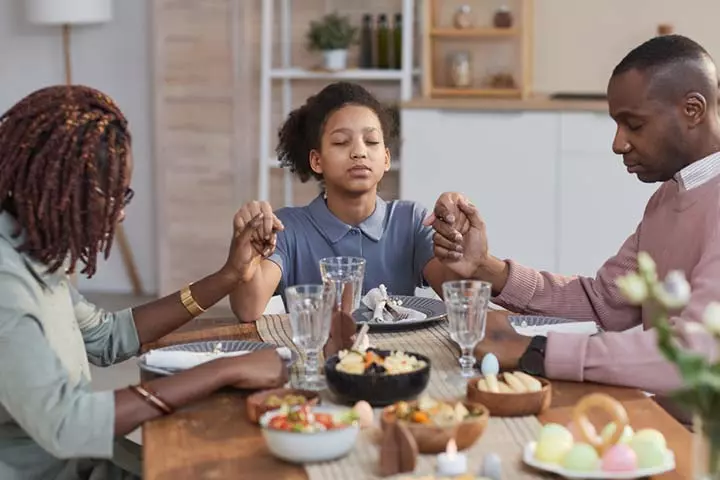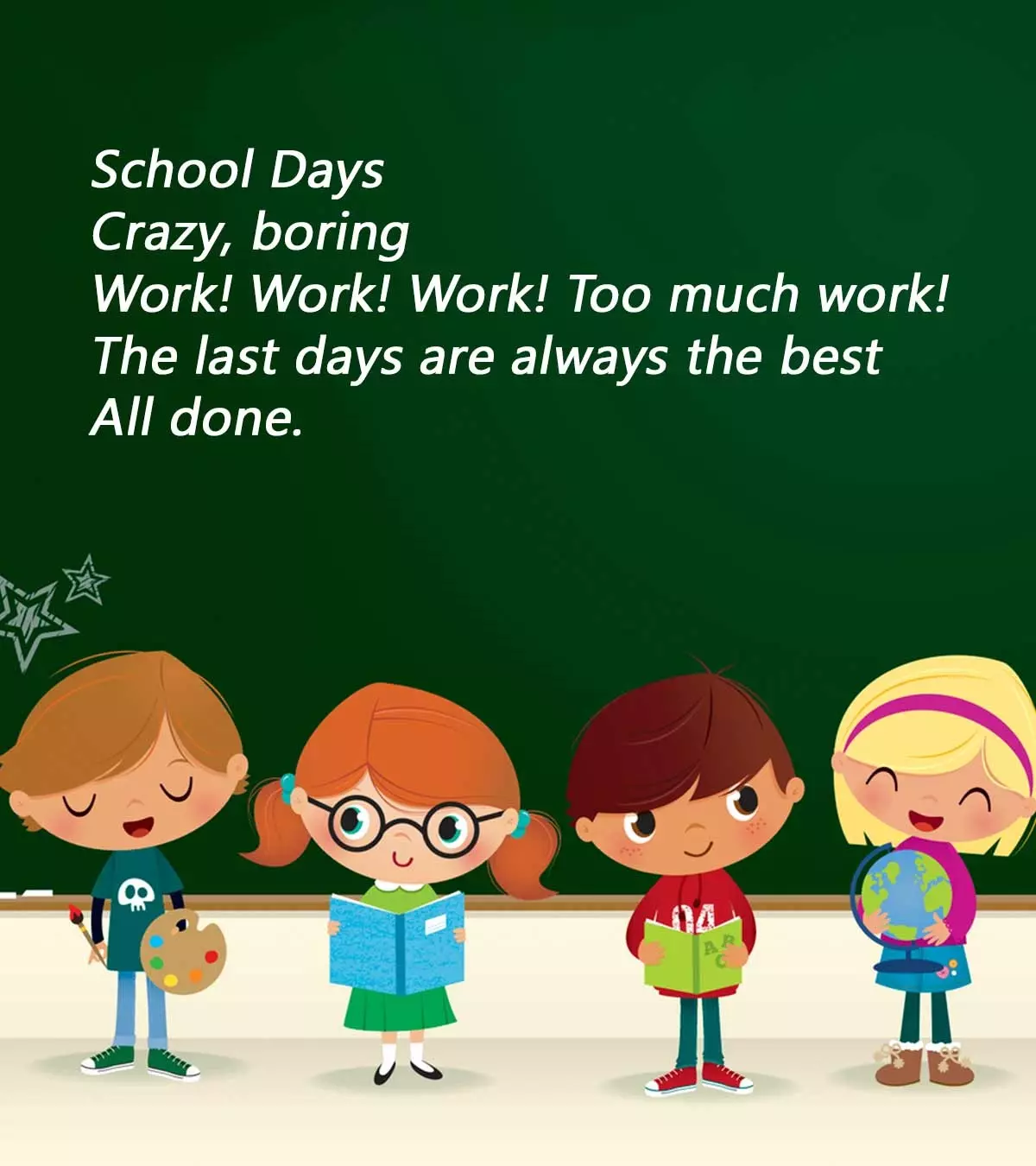
Image: Shutterstock
Children learn everything from their surroundings. So, teaching table manners for kids is a continuous process that should start in their formative years. Table manners should be routine in every household to see and learn them at a young age. Simple things, such as saying “please” and “thank you,” sitting properly, and waiting for everyone to be served, are easy for a child to observe and follow. So make an effort to explain to your child why table manners are important. Let them know why certain things are done in a specific way and what is right and wrong. Also, they are supposed to behave and be quiet when having food. Here we discuss why you should teach children table manners at a younger age and bring you some basic table manners that are easy to teach.

Key Pointers
- Teaching table manners can help your children learn to appreciate the food served and acknowledge the effort to prepare it.
- Washing hands before meals or not allowing them to play with food can be taught from a young age
- As the child grows, you can teach them using table cutlery or encouraging a conversation at the table.
Why Should Children Learn Table Manners?
Children are not born with manners. Manners and good behavior have to be inculcated in them over time. Children love to make playtime out of every situation, and you can’t really blame them, as it is the age to have fun.
But once you take your child out to a family dinner, a restaurant, or any social gathering, you suddenly feel embarrassed at what a mess or ruckus your child causes while dining. Teaching children table manners and social etiquette can stand them in good stead for the rest of their lives.
By teaching them good table manners, you are showing them how to conduct themselves in public. They will learn to appreciate the food served to them and acknowledge the effort to prepare it. They will also learn to respect food, which they are lucky to get. Moreover, when children learn table manners, they will impress others and not offend anyone in any social setting.
Every parent has their own preferences when it comes to teaching their children table manners. For instance, Jennifer, a mother, says, “A little pet peeve of mine is when the kids start to eat before prayer is said, or they rush to the front of the line instead of respecting their elders and preferring one another and also gulping their food down and then leaving the table before anyone else has even had a chance to take a bite! Sorry, maybe that’s three pet peeves. These are just things that I work on with my kids. They may not be as important to you and that’s fine. My kids have not arrived, but it’s all in the training. I know that it is not in vain (i) !”
At What Age Can You Teach Table Manners To Children?
Starting at a tender age is always good. Children learn through observation, so once your child transitions from the toddler meal chair to the table, that is, anywhere between 18 months and three years, start with a few simple ones, such as “chew with your mouth closed” or “don’t play with food.”
As the child grows, increase the intensity of the teachings, such as helping around meal times and clearing your own plates. Eventually, they can learn formal table etiquette, such as how to hold a fork and a knife or how to lay the table for different occasions.
There is no fixed age for learning table manners. Learning is a continuous process, so begin with teaching good manners for kids through examples and slowly move to dinner-table rules.
15+ Table Manners Children Need To Learn And Follow
Here are some crucial table manners for kids you can start inculcating in them at a young age.
1. Wash your hands before meals

Children often play in the dirt and touch everything they can lay their hands on. Teach them to come to the table with clean hands and face so that they do not carry germs and look messy to everyone around the table. It’s an important aspect of maintaining good personal hygiene for kids.
 Point to consider
Point to consider2. Keep the napkin on your lap
Teach your child to lay the napkin neatly on their lap as soon as they sit for mealtime. Let them know this keeps their clothes clean in case of food dropping. Also, teach them to use the napkin to wipe their hands or mouth.
3. Wait for everyone

Teach your child to wait for everyone to be seated and served before they start to eat. Usually, the elder of the house says grace (in religious homes, and then everyone starts eating.
4. Do not pick food
Children love to pick food out of the main dish to taste or pick finger food out of the bowl before everyone is seated. They also tend to pick food from other people’s plates. If a child has finished their fries, they love to reach out to their parents’ plates or a sibling’s plate and pick a fry or two. Teach them politeness. They should ask for permission before eating what is on other people’s plates.
5. Do not play with food

Children love to play with food, especially if they are not great eaters or the food is not of their choice. For children who can eat by themselves, do not allow them to play with their food on the table. No slurping spaghetti or putting tomato rings around the eyes to look through them, and definitely, no forming words out of alphabet pasta. They should not play with the utensils too.
6. Do not talk with food in the mouth
Children usually have many stories to share and can’t wait to say what’s on their mind. Although you should encourage your child to engage with family and share their daily experiences, you have to teach them to finish chewing what’s in their mouth before speaking.
7. Chew silently
This does not mean not talking to people at the table. Dinner conversations are the best way to engage with your child. But children do not realize how they are eating. They unintentionally tend to slurp their drink and chomp their food. Some children also find it funny to burp loudly while eating. Teach them to excuse themselves if they cannot hold it in, and tell them it is rude to burp loudly.
8. Converse with everyone at the table

If you are at a family dinner, teach your child to engage with everyone and not just with a cousin or parent. Encourage them to make conversation with different people and not look rude by carrying on a conversation with a single person. Let them know it is disrespectful to sit around a table and leave some people out of a conversation.
 Do remember
Do remember9. Ask for the food to be passed
Children are usually impatient. When they want something from across the table, they instinctively stand up and reach for it. Teach your child to remain seated and ask for the bowl to be passed. If someone is serving, teach them to wait until the server reaches them.
10. Do not dip from the same bowl
If there are finger foods or dry foods, such as nachos and fries, children like to dip their food in a common bowl of sauce or dip. Not everyone likes sharing from the same bowl. Teach your child to use a spoon and put the required amount of the sauce or dip onto their plate and dip the food in that.
11. Keep the elbows and other body parts off the table
This is a universal rule of courtesy. One must keep one’s elbows and other body parts off the table. Discourage children from waiting for food with their chin on the table. Some kids try all sorts of angles and positions — knees up and head down — because they find eating boring and are just restless. Either way, teach your child to sit properly at the meal table.
12. Use the golden phrases
“Please,” “thank you,” and “excuse me” are important phrases a child must learn. These words should become an integral part of their vocabulary. At the table, they must say “please” when asking for something or want something passed and say “thank you” after being served. At the end of the meal, make sure you teach your child to thank the person who has cooked and served the meal.
13. Ask to be excused when done
Sometimes, adults like to sit around the table and continue talking after the meal. This mostly happens when friends or other guests are around. Teach your child not to sit around listening to the conversation. Once they are done, they should ask to be excused and leave the table, preferably with their empty plates. Teach them good communication skills to manage this task easily.
 Point to consider
Point to consider14. Offer help

At home, inculcate the habit of picking up their own plates after a meal. If you are out for a meal at someone’s house, teach your child to help lay the food or clean up after the meal.
15. Do not waste food
This could be a bit tricky for children as they are not sure how much they can eat. Children waste food for various reasons. They could be fussy eaters, or they could have been starving and served themselves more than they can eat. Teach your child to take small quantities at a time. If they are still hungry or like the food, tell them they can ask for more. Teach your child to respect food.
16. Express gratitude for every meal
Expressing gratitude for every meal is an important table manners children can follow. So, teach your children to say thank you for every meal so they understand and appreciate the effort that goes into making it. More than the food, saying thanks at the table is about good manners. This should be one of the most important house rules for kids as it teaches them to respect food and makes mealtime more positive.
17. Do not burp while eating
Not burping while eating is an important table manners for children for a few reasons. First, it’s considered polite and respectful to those around you. Burping loudly can make others uncomfortable during a meal. Second, it promotes cleanliness and good hygiene at the table. Burping with your mouth closed is a more considerate way to handle it. Lastly, it helps children to be aware of their actions in social situations.
Fun Activities To Teach Table Manners
Here’s a simple guide to make learning table manners fun for kids.
- Role-playing: Set up a pretend dinner table where kids can practice good manners in a relaxed way.
- Table manners bingo: Create bingo cards with different table manners and play as a family during meals.
- Manners charades: Take turns showing right and wrong ways to act at the table.
- Practice restaurant at home: Make your home into a pretend restaurant where kids learn to order food and use their fork and knife correctly.
- Share kind words: Have everyone say something nice during dinner to teach kids how to have good conversations at the table.
Frequently Asked Questions
1. Why is it important to sit up straight and not slouch while eating?
Slouching while eating may put pressure on the stomach and cause a reflux of the gastric contents. This may result in heartburn. Slouching may also cause a slowing down of intestinal movements (1). Proper posture can improve digestion.
2. Why should we take small bites instead of stuffing our mouths?
Small bites may help you eat slowly and chew thoroughly before you swallow your food. This may prevent overeating and aid digestion (2).
3. Should children be allowed to use electronic devices at the table?
Meal times provide a chance for the family to get together and share their experiences of the day while enjoying delicious food. So using electric devices at the table takes away from this experience and can prevent communication and relationship building. It also fosters unhealthy eating habits where children may be unable to enjoy their food.
4. What should I do if my child accidentally spills food or drinks at the table?
Stay calm and assure them that spills may happen, but they should be careful next time. Ask them to take responsibility for cleaning the mess, but if your child is too young, demonstrate the proper cleaning technique and the right way to handle their food to prevent similar accidents.
5. What should I do if my child refuses to use proper table manners?
If your child refuses to use table etiquette, regularly model good table manners yourself. Communicate your expectations through a positive, firm, but non-threatening tone. However, they may not follow the rules immediately. So stay patient and try using alternative fun approaches such as pretend plays to make them more adaptable.
6. What causes bad table manners?
An absence of proper knowledge about table manners may cause one to display odd behavior. In addition, people who are not familiar with or exposed to dining experiences due to cultural practices or poor role models may not know how to eat with others. Moreover, distractions and a lack of consideration or awareness can also lead to bad table manners.
7. What are common mistakes parents make when teaching table manners?
Some common mistakes parents make when teaching table manners include being too strict or critical, comparing their children to other children, failing to set a good example themselves, introducing too many rules at once, and not considering a child’s age or developmental stage when setting expectations.
Basic table manners for kids can be taught from as early as 18 months. It will save you from embarrassment when you take your child to a family dinner, restaurant, or other social gatherings. Washing hands before and after each meal, waiting for everyone at the table before beginning to eat food, and eating silently are some simple yet essential table manners and habits parents should teach their children. Also, educate your child that talking with a full mouth and playing with or wasting food are frowned upon. Some families may have certain traditions according to their culture. Teach your children to respect them. Instilling such manners and family values in your kids from a young age will help them imbibe better.
Infographic: Good Manners For Children
Parents should start teaching their children how to carry and conduct themselves in social situations from a young age to ensure they become responsible and law-abiding citizens. In this infographic, we list the rules to follow to ensure they maintain basic decorum in public. You may print it and share it with your child.
Some thing wrong with infographic shortcode. please verify shortcode syntax
Illustration: Table Manners For Kids Of Every Age To Learn And Follow

Image: Dall·E/MomJunction Design Team
Learn how to be a polite dinner guest with these helpful tips on table manners for kids. Good habits and manners will make dining out a pleasant experience.
Personal Experience: Source
MomJunction articles include first-hand experiences to provide you with better insights through real-life narratives. Here are the sources of personal accounts referenced in this article.
i. Table manners.https://livingonpbj.wordpress.com/2013/06/28/table-manners/
References
- 3 surprising risks of poor posture.
https://www.health.harvard.edu/staying-healthy/3-surprising-risks-of-poor-posture - Quick Dose: Is Eating Too Fast Unhealthy?
https://www.nm.org/healthbeat/healthy-tips/nutrition/quick-dose-is-eating-too-fast-unhealthy
Community Experiences
Join the conversation and become a part of our nurturing community! Share your stories, experiences, and insights to connect with fellow parents.
Read full bio of Dr. Maymunah Yusuf Kadiri
Read full bio of Bharathi V
Read full bio of Harshita Makvana
Read full bio of Kavita Kankani


















